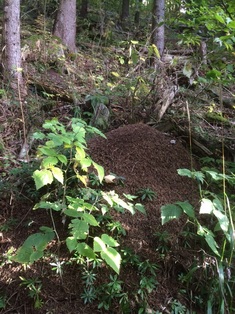“H” Colony- ANT HILL BLOG DAY 3- 26th October 2015
On the 3rd day, we went back to our one specific ant hill and investigate on the Ant Hill surroundings. We had to locate three nearest trees to our ant hill, and measured the distance from each tree to the ant hill. We also had to identify the tree’s species. After we had to measure the circumference of each other tree we chose. After all of the data collecting, we had to plot the positions of where the trees are around the ant hill and also their coordinates. After, we did some predictions, the percentage of the sky that is covered with trees, the percentage of the ground being covered by green plants and mosses. Lastly, we rated the activeness of the Ant Hill and took pictures during our investigation, as shown below.
Guiding Questions:
1) Why might it be interesting to record the size and species of the trees surrounding the colonies?
2) If you wanted to study the effect of tree size on the size of the and colonies, what would be your dependent variable? Your independent variable?
My dependent variable would be the size of the trees and colonies. The dependent variable would be which colony we choose.
3) During the winter months, the snow will often melt off the ant mounds before it melts off the surrounding area. What process of the heat that melts the snow?
Tree Species
Number of Tree
Species of Tree
Circumference (cm)
Distance from Tree to Colony (cm)
1
Coniferous
98.5
40
2
Coniferous
81
86
3
Coniferous
90
366
4
Coniferous
64
289
5
Coniferous
83
186
Coordinates
#1: 46 20 28 N, 6 59 60 E, 344 N
#2: 46 20 28 N, 6 59 60 E, 349 N
#3: 46 20 28 N, 6 59 60 E, 330 NW
#4: 46 20 28 N, 6 59 60 E, 330 NW
#5: 46 20 28 N, 6 59 60 E, 159 S
Canopy Cover: 62.5%
Green Ground Cover: 40%
Ants Activity: 3/10
Height of Colony: 134 cm
Diameter of Colony: 146 cm
On the 3rd day, we went back to our one specific ant hill and investigate on the Ant Hill surroundings. We had to locate three nearest trees to our ant hill, and measured the distance from each tree to the ant hill. We also had to identify the tree’s species. After we had to measure the circumference of each other tree we chose. After all of the data collecting, we had to plot the positions of where the trees are around the ant hill and also their coordinates. After, we did some predictions, the percentage of the sky that is covered with trees, the percentage of the ground being covered by green plants and mosses. Lastly, we rated the activeness of the Ant Hill and took pictures during our investigation, as shown below.
Guiding Questions:
1) Why might it be interesting to record the size and species of the trees surrounding the colonies?
- It might be interesting, so that we know the average size and type of the trees surrounding our Ant Colony, and how the size and type of the trees affects our Ant Colony (life of the ants and their food).
2) If you wanted to study the effect of tree size on the size of the and colonies, what would be your dependent variable? Your independent variable?
My dependent variable would be the size of the trees and colonies. The dependent variable would be which colony we choose.
3) During the winter months, the snow will often melt off the ant mounds before it melts off the surrounding area. What process of the heat that melts the snow?
- The snow melts because of the ants giving out energy, and the result of this, the heat from the energy would cause the snow to melt off the ant mound.
Tree Species
- Larch
- Larch
- Larch
Number of Tree
Species of Tree
Circumference (cm)
Distance from Tree to Colony (cm)
1
Coniferous
98.5
40
2
Coniferous
81
86
3
Coniferous
90
366
4
Coniferous
64
289
5
Coniferous
83
186
Coordinates
#1: 46 20 28 N, 6 59 60 E, 344 N
#2: 46 20 28 N, 6 59 60 E, 349 N
#3: 46 20 28 N, 6 59 60 E, 330 NW
#4: 46 20 28 N, 6 59 60 E, 330 NW
#5: 46 20 28 N, 6 59 60 E, 159 S
Canopy Cover: 62.5%
Green Ground Cover: 40%
Ants Activity: 3/10
Height of Colony: 134 cm
Diameter of Colony: 146 cm

 RSS Feed
RSS Feed
